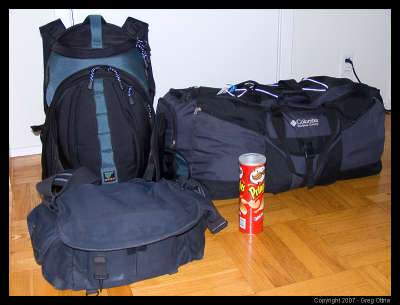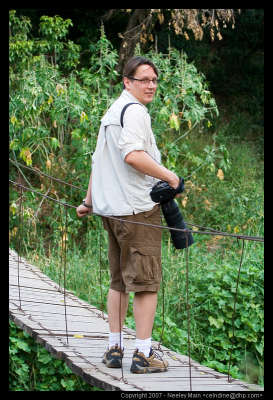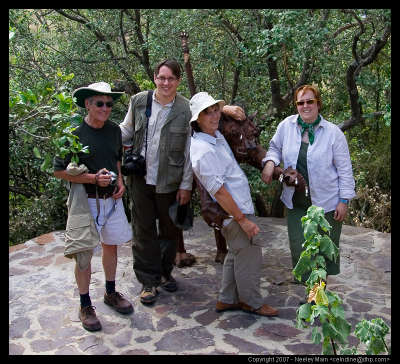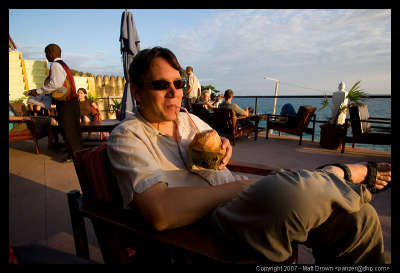Technical Information and other Ramblings
|
We had some strange requirements on this vacation, cold rainy northern
Scotland to warm savannah of Tanzania in one trip. A month of clothes and
personal gear. And we haven't even talked about the extra luggage to
bring back gifts for people. Neeley and I carried a lot of equipment on
this trip, some of it was even useful. The pringles can is included to
help so scale (pringles being a universal size indicator).
Camera gear was my primary concern for our safari. This was not a trip
that I was expecting to be able to do a couple times a year, so I wanted
to make sure that I had the equipment that I felt was required.
|
 |
 |
For that reason, I packed quite a bit of camera gear for us to use:
- Canon 20D Body (with grip) & Canon Rebel XT Body
- Canon 100-400 f4.5-5.6 L IS
- Sigma 120-300 f2.8
- Sigma 50-500 f4-6
- Canon 80-200 f2.8 L
- Canon 17-85 f4-5.6 IS
- Canon 17-55 f2.8
- Canon 10-22 f3.5-4.5
- Sigma 2x TC & Kenko 1.4x TC
- Canon 550ex & 420ex Flashes
Neeley carried the Rebel XT, 17-85, and the 420ex in her bag. While I
carried all the remaining equipment in a Kata HB-207 backpack. In
additional to the camera gear, the bag also held the other technical bits
you need to lug around. In this case, a Thinkpad X30 laptop, a Hyderdrive
HD80 backup unit, and a Canon Pro1 Point and Shoot camera, Better Beamer
unit for the 550ex flash, blower, lenspens, couple polarizing filters,
chargers, and extra batteries for all the electronics.
My gear bag weighed in at over 40 pounds at this point.
|
|
After packing my duffel bag with clothes and electronics that didn't fit
in the camera bag, it was also around 40 pounds. This was a lot of weight
to be carrying around, and the duffel bag had no wheels to make it easier.
In hindsight I would not suggest a this type of solution. The weight
savings of the simple duffel over the light weight wheeled luggage (3
pounds vs 8 pounds) was in the end, not worth it for the treks in
airports. The proper solution is to bring less stuff. In this case, less
clothes.
Things to remember, is that a Tanzanian safari is done entirely from
vehicles. Tripods are not going to work. You should be able to clamp on
ball heads onto the top of the truck in many cases. Or you can lash down
bean bags, which is what I ended up doing. For the 100-400, this wasn't
really needed. But for the 6 pound 120-300, the bean bags helped quite a
bit in stabilizing the camera.
Speaking of working from a vehicle. Ensure that all your equipment that
you plan on using is readily available, without requiring a huge amount of
open space. The kata backpack was a bit problematic with 4 people in the
back of the truck due to the way it opened with the hinge at the bottom.
The reinforcement on the bag required me to unzip all the way, and open it
up to get in. This was a bit of a pain. You can practice how things
work at home, get into the backseat of your car with your gear and see how
your bags, pouches, etc all work. I ended up carrying TC's in my vest
pockets, along with an extra battery.
|
 |
We had a pop top land cruiser, with the top rising up on support bars.
I've seen suggestions that say to try to avoid this, so that you can pan
easily. Since you can lean forward, these caused me no trouble at all.
The raised top, versus the removed or sliding top appealed to me due to
the ability to have shade in the truck while shooting. You end up driving
around in the middle of the day, not just early morning and evening, the
shade is good.
If I get a chance for another safari I would easily suggest two bodies for
each photographer. In direct conflict to my above comments about weight.
You'll end up with a 100-400 or similar on one body, but there were a
number of times, where the 17-55 or similar medium length (I'm on a 1.6x
crop factor body) would have been very useful. Having the lions walk
right up to the truck for example.
Dust was not a problem except around Ngorongoro Crater area, which is
filled with fine billowing dust everywhere. There is dust in the air
elsewhere, but the environment overall was nothing that hostile for the
camera gear. I had no failures of equipment on this trip.
Clothing seems to come up on safari web sites quite a bit. I spent a
large amount of time trying to track down super light weight shirts and
pants for the trip, before actually looking at the weather history. July
in Tanzania is almost identical to Northern California, where I live. The
temperatures where mid 70's to 80's in the day time, and it got cold
enough to want a fleece jacket in the evening. The balloon ride was also
chilly. Basic shirts and pants that are comfortable to sit around in a
car all day are important. Shoes follow the same principle. You won't be
hiking, so something like sandals may even be an option, but I would
suggest something to cover your feet with for the temps in the evening.
The Tstete flies. They are out there, and they hurt like horse flies when
you get bit (direct experience). The bug sprays on the clothes and
applied during the day seemed to have a minor effect, just please leave
all your bug spray with your guide when you leave, as it doesn't appear to
be common for them to have any. Mashoka knew where the infested areas
where, and we stayed away. For the most part they were around, and you
will end up killing them, though you shouldn't get bitten often.
My workflow during the safari was quite easy with the HD80 unit, and my
laptop. I ended up never running out of CF cards while out during the day
time (we had about 10 gigs worth of cards). In the evening, I would copy
the CF cards to the HD80, and the laptop. This gave me two copies in case
of failure. I didn't bother doing editing, but I did bring the laptop to
review shots taken during the day. We shot entirely in RAW mode on both
cameras.
We shot around 3800 pictures on this trip, and these web pages give you
approximately 350 of the better ones. My shooting habits didn't appear to
change too much when shooting out on the safari. You'll shoot at about
the same regularity as you do when you are out at home.
With hindsight now, there are a handful of minor things I would do
differently. The most obvious, pack far less. You can have laundry done
while you are staying at camps, and this reduces the total clothes you
need to wear (if you are female, please note that many camps don't wash
"female intimates", you'll be hand washing those).
The next thing I would change is to provide a schedule that allows for
only 1/2 day game drives. It's not entirely apparent in the previous
descriptions, but these are long days. Having some down time to rest a
bit would have helped considerably.
Something that goes hand in hand with a little more down time. Talk to
your guide and see if there are places you can just sit and watch and
wait. We drove around quite a bit searching, except for the river
crossing stop we made at one point. Sitting for an hour during the
migration to watch the animals is quite interesting, and you get a chance
to hear them.
Other than that, it's minor things. Third camera body with wide-medium
lens on it so we could have grabbed that. Make sure you bring some small
video camera with audio. We had one, and seeing movement and listening to
things like the zebra's bark is worth it.
Overall this entire trip was something I would like to try again in the
future. And suggest it to anyone who thinks about it, it's worth it to be
able to see many of these animals, and the environment they live in.
 |
-Matt
|



